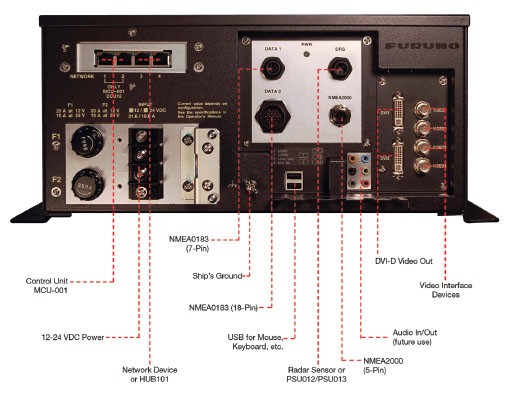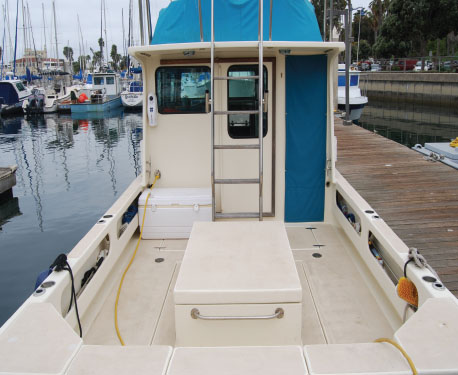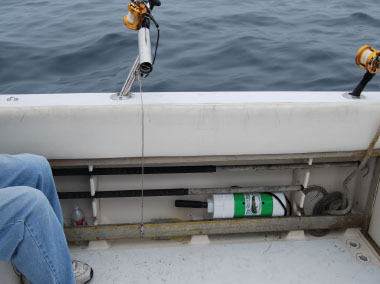 Black box boat electronics give you big-boat electronics with a small-boat footprint. You would need a helm station several feet across to fit all the stand-alone units that one small black box system can put on the helm station of a small fishing boat with maybe as little as 1.5 feet of space.
Black box boat electronics give you big-boat electronics with a small-boat footprint. You would need a helm station several feet across to fit all the stand-alone units that one small black box system can put on the helm station of a small fishing boat with maybe as little as 1.5 feet of space.
There is a profound functional advantage to a black box system and companion multi-use, programmable display. Instead of scanning a multitude of stand-alone screens, as is necessary with all such units, a black box system integrates displays into one large and manageable multi-purpose display screen. This technology makes your boat feel like a million bucks while helping you assimilate the various vital pieces of information quickly and easily as you simultaneously try to navigate, monitor engine and other systems performance and find fish.
“A black box system gives the flexibility to use virtually any size display,” says Jeff Kauzlaric, Advertising & Communications manager at Furuno. “In some instances, you can plug in two displays, allowing you to clone the display in another area, like the salon, deck or fly bridge. Another advantage that usually comes with a black box is expandability. The black box gives more room for network hubs, allowing you to connect more sensors. Finally, in some cases, the processor inside a black box may actually be faster and more powerful than a stand-alone Multi-Function Display (MFD) with a built-in screen.”
 I put this to Kauzlaric: “I’m trying not to leave out possibilities. Stuff that can be connected to and displayed/controlled by a black box system include: transducer, radar, GPS, engine monitoring, cameras, music systems, auto-pilot and probably a few others. What is the newest gadgetry that can be connected and what am I leaving out?”
I put this to Kauzlaric: “I’m trying not to leave out possibilities. Stuff that can be connected to and displayed/controlled by a black box system include: transducer, radar, GPS, engine monitoring, cameras, music systems, auto-pilot and probably a few others. What is the newest gadgetry that can be connected and what am I leaving out?”
His response: “How about tablets and smartphones? Some other items are AIS, Weatherfax, satellite compasses, Sirius/XM Weather Receiver.”
He provided this good link to learn more: http://www.navnet.com/network/index.html.
Marine electronics have become much better marinized in recent years, thanks to better performing materials, so exposure to saltwater spray and air is not the death sentence that it once was. Even so, there is something comforting about mounting that black box computer behind bulkheads and down out of the way of wet air and salt spray. Aesthetics are important because we do enjoy an uncluttered, elegant-looking fishing machine. A black box system allows cables and leads and wiring to pass from sensors to the black box below decks. On the helm station is only a large screen with a cable harness coming from the black box. It just looks great!
Cockpit Organization
When the fishing gets fast and furious during a WFO bite, there is a time when nothing is more important than the organization of a boat’s cockpit. Thoughtful preparation can make or break a bite. It can aid anglers in being effective and help crew be efficient. When not done right, the results are lost fish, stumbling people, tools (gaffs, nets, etc.) where they can’t be quickly accessed and possibly even injury to people and crew.
 The best way to organize a cockpit is to stand and stare at it while in your mind’s eye you envision an all-out hot, wild bite with multiple hookups and people scrambling to control their fish and get as many as possible aboard the boat. Then think about what people and crew members need to do: move freely and quickly around in the cockpit, untangle or cut lines, net or gaff fish, mark and stow the fish, bait up anglers and keep everyone fishing, all the while doling out just enough chum to keep the fish feeding around the boat.
The best way to organize a cockpit is to stand and stare at it while in your mind’s eye you envision an all-out hot, wild bite with multiple hookups and people scrambling to control their fish and get as many as possible aboard the boat. Then think about what people and crew members need to do: move freely and quickly around in the cockpit, untangle or cut lines, net or gaff fish, mark and stow the fish, bait up anglers and keep everyone fishing, all the while doling out just enough chum to keep the fish feeding around the boat.
Cockpit organization is all about managing chaos. The nature of the chaos is very different from one targeted fish to another, so rearrange your cockpit each time you go after another species of fish. Salmon fishing requires different tackle and tools than albacore fishing or halibut fishing or white seabass fishing or lingcod and rockfish. Your boat will be far too messy and inefficient if you leave out all gear needed for all the types of fishing you do throughout the year.
Here are a few important tips for organizing the cockpit:
1) Consider reorganizing your rod holders and rocket launchers. Gunnel-mounted rod holders should be mounted at angles to support the types of fishing you do with your boat. If you mostly troll, angle your rod holders to increase your trolling spread. You can buy outrodders to change the angle of individual rod holders for those times when you mooch or sit at anchor and soak baits. Put your rocket launchers where you can get to them, but at angles that keep those stored rod tips out of the way of the action. Rocket launchers mounted at angles that put rod tips back over the fighting cockpit spell nothing but trouble.
2) Remove anything and everything that will not be needed for the type of fishing being done today. Just doing that tends to clear the cockpit and allow some degree of organization to the chaos of a great bite. Only keep what you will need today in the cockpit. Never have spare rods leaning on rails, just in case they are needed. Stow them out of the way, in rocket launchers or in the cabin (when there is a cabin).
 3) Clear the deck for action! During a good bite, everyone’s focus is outside of the boat; on the rail they have to maneuver along to stay in front of their fish, or at what is coming over the rail. No one is looking at their feet, so any tackle or other stuff that is sitting on the deck will become stumbling blocks. Stow everything safely out of the way of the action. Make people go get the hooks, lures, weights, etc., that they need, out of their boxes which are placed well out of the way of the action. Doing so will save injuries and lost fish.
3) Clear the deck for action! During a good bite, everyone’s focus is outside of the boat; on the rail they have to maneuver along to stay in front of their fish, or at what is coming over the rail. No one is looking at their feet, so any tackle or other stuff that is sitting on the deck will become stumbling blocks. Stow everything safely out of the way of the action. Make people go get the hooks, lures, weights, etc., that they need, out of their boxes which are placed well out of the way of the action. Doing so will save injuries and lost fish.
Here is something that ranks right up there with clearing the deck for action: Keeping the deck clean. When fish start coming over the rail, or bait/chum is dropped on the decks, they get really slippery. It is most often people who are hooked up to fish who move the quickest and slip on the slimy deck. Keep a bucket of seawater at the ready and take a moment to sluice the deck. ■

